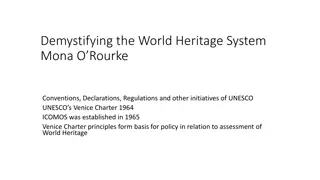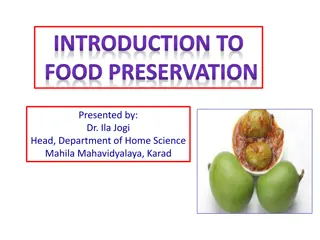UNESCO PERSIST Content Selection Guidelines: Long-Term Preservation Strategy
Providing guidance to memory and cultural institutions on selecting digital heritage for preservation, the UNESCO PERSIST Content Task Force emphasizes the importance of safeguarding digital materials for future generations. Highlighting the risk of losing valuable heritage, the guidelines stress the need for defining preservation strategies to ensure the survival of digital assets. The guidelines, not legally binding but encouraged as best practices, cater to libraries, archives, and museums aiming to preserve digital heritage in the long term.
Download Presentation

Please find below an Image/Link to download the presentation.
The content on the website is provided AS IS for your information and personal use only. It may not be sold, licensed, or shared on other websites without obtaining consent from the author.If you encounter any issues during the download, it is possible that the publisher has removed the file from their server.
You are allowed to download the files provided on this website for personal or commercial use, subject to the condition that they are used lawfully. All files are the property of their respective owners.
The content on the website is provided AS IS for your information and personal use only. It may not be sold, licensed, or shared on other websites without obtaining consent from the author.
E N D
Presentation Transcript
The UNESCO PERSIST Content Task Force Guidelines for the selection of digital heritage for long-term preservation Cl ment Oury ISSN International Centre PERSIST Content Task Force clement.oury@issn.org
Agenda of the session Presentation of the guidelines Comments on the guidelines from the panel Open discussion with the public
Why preserving digital heritage? Heritage is at risk of being lost forever Sheer volume of information But highly ephemeral Ensure survival of digital heritage for the next generations and beyond A need for heritage institutions to define their digital heritage preservation strategy
The PERSIST project PERSIST: Platform to Enhance the Sustainability of the Information Society Transglobaly A progressive maturation Memory of the World 2012 conference in Vancouver December 2013: international conference in the Hague, launch of PERSIST Aroadmap for three task forces Selection Policy Technology
Content Selection Guidelines the context The Content Task Force was created to provide guidance to memory and cultural institutions on selecting digital material for long term preservation. UNESCO: UNESCO Guidelines are not legally binding. Member states are invited to apply them as the baseline or best practices. Guidelines are not a list of recipes!
Content Selection Guidelines the context (cont d) The Content SelectionGuidelinesare designed primarily for libraries, archives and museums A Generic Framework: for general application (with advice on specific application) Audience: aim at a diverse audience including professionals and administrators who deal with digital materials and plan to prepare a policy on selection of digital materials for long-term preservation.
The authors of the Guidelines Chair: Ingrid Parent (University of British Columbia) Secretary: Julia Brungs (IFLA) Authors: Ngian Lek Choh (National Library Board of Singapore IFLA Governing Board, Singapore) Clement Oury (ISSN International Centre, France) Katarzyna laska (National Library of Poland, Poland) Sarah CC Choy (Legislative Council Archives, Hong Kong) Robert Fisher (Library and Archives Canada, Canada) Nicholas Crofts (ICOM, CIDOC, Switzerland) Susanne Nickel (City Museum of Eskilstuna, Sweden)
Background how did we get here? The Paradox of Selection in the Digital Age -- T. and B. Van der Werf (August 2014) Survey on existing digital selection policy W. Helmus (April 2015) The Content Task Force created a working group of experts to draft the Guidelines for the selection of digital heritage for long-term preservation in April 2015 Extensive consultation throughout 2015
Challenges we encountered Different terminology used by librarians, archivists and museum professionals Diversity of the heritage community - Guidelines to be applied by libraries, archives, and museums of all shapes and sizes Different professional focuses and priorities: Libraries issues relating to legal deposit, e-publications, harvesting websites and social media sites, and short-term vs. long-term use
Challenges we encountered Museums born-digital material / digital or digitized information about the collection / digital representations of physical artefacts. Importance of metadata and context information Archives authenticity of records, early selection and transfer, reappraisal, costs, regulatory restrictions on access and use Private sector in background Some issues not tackled: e.g. ethics
Identifying success conditions Networking Critical role of the national/central institution Which cannot act without the support of a network Legal environment IP rights issues; privacy; state secrets Institutions need to be mandated Technical skills Metadata management Digital preservation
The selection paradox Selection is not possible New forms of digital heritage that should not be forgot Collectively valuable as a record of contemporary societies Selection is mandatory Huge amount of resources created by digital technologies Selection strategies should be adopted Comprehensive collection Representative collection Selection
Criteria for Selection Guidelines We MUST select, based on: Three main criteria Significance Sustainability Availability A decision tree for selection in individual institution
Questions, Comments and Suggestions Cultural.heritage@ifla.org Julia.Brungs@ifla.org
Questions for the panel Do you have a collecting policy/strategy For digital documents? What are digital preservation issues in your institutions? How to use/implement guidelines?























